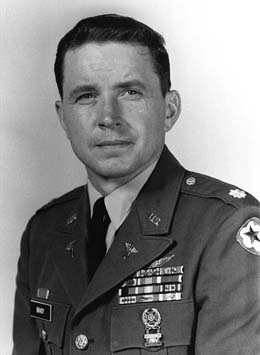On October 9, 1969, Seattle University graduate Patrick H. Brady (b. 1936) receives the Medal of Honor for his valor in combat during the war in Vietnam. On January 6, 1968, Major Brady, a pilot in the army's Medical Service Corps, flew four helicopter rescue flights to recover wounded soldiers and deliver them quickly to medical treatment stations. The rescues involved flying into enemy-held locations under fire. Enemy fire disabled three of the helicopters he piloted that day. Through his efforts he was able to rescue 51 men. Their prompt rescue saved many lives. For this act of valor Brady is awarded the Medal of Honor. The award ceremony is held at the White House with President Richard M. Nixon (1913-1994) presenting the medal.
From Seattle University to Vietnam
Patrick Henry Brady was born in Philip, South Dakota, in 1936 and grew up in Seattle, attending Seattle's O'Dea High School. Brady graduated from Seattle University in 1959 with a psychology degree, having completed the Reserve Officer Training Corps (ROTC) program. He was commissioned as a second lieutenant in the army's Medical Service Corps. In 1961 he started his first duty assignment, a three-year tour in Berlin, Germany, as a medical platoon leader at the 279th Station Hospital. Seeking a greater challenge, he applied for and was accepted into the Army Aviation School at Fort Rucker, Alabama. He became a helicopter pilot flying air ambulance missions, known in the military as "Dust Off" missions.
In 1963 Brady was sent to Vietnam and flew with the 57th Medical Detachment. He was wounded during a September 23, 1964, night rescue flight. While Captain Brady and his copilot were attempting to rescue a downed pilot they were both hit by enemy fire. They flew back to base for treatment while gun airships kept the enemy under fire and pinned down. The next morning a medevac flight rescued the pilot. On November 28, 1964, at the 57th base in Saigon, Brady received the Distinguished Flying Cross, Bronze Star, Air Medal, and Purple Heart. In January 1965 Brady returned to the United States and following home leave in Seattle went to Fort Benning, Georgia. There he flew support flights for units training for Vietnam service.
Medal of Honor
The heroic actions of Major Brady on January 6, 1968, during his second tour to Vietnam, are described in his Medal of Honor citation. He was assigned to the 54th Medical Detachment at Chu Lai, flying a UH-1H Iroquois "Huey" medevac helicopter. That day he volunteered to attempt the rescue of two badly wounded South Vietnamese soldiers in enemy territory. Bad weather the previous day had blocked a rescue attempt. When Brady arrived at the site there was still thick fog, but he was able to locate and rescue the men despite enemy fire. Brady flew the injured soldiers to a medical treatment facility. Soon after that he responded to a radio call to rescue 39 American soldiers. Their rescue required five flights in just over one hour. His next mission that day was to medevac wounded South Vietnamese soldiers. Despite enemy fire that damaged his helicopter controls he got the wounded out.
At Chu Lai base Major Brady received a replacement helicopter and flew his fourth mission of the day. On this mission he observed another medevac disabled by a mine explosion during an evacuation effort. It had landed in a minefield. Brady carefully landed his aircraft avoiding the mines. His crew went out into the minefield to bring back six American soldiers. As the crew carried one wounded man on a stretcher, a mine exploded. The explosion blew a hole in Brady's helicopter. Still, he was able to fly out and deliver the six wounded to a medical aid station. Major Brady found another replacement helicopter and remained on alert ready for additional missions. His four missions had rescued 51 men, many of whom would likely have died without prompt medical treatment. Maintenance crews counted 400 bullet holes in the three aircraft he used that day.
Brady returned to the United States and was awarded the Distinguished Service Cross for his valor. This was upgraded to the Medal of Honor. On October 9, 1969, in a White House ceremony, President Richard M. Nixon presented the medal to Major Brady. It was the first Medal of Honor for a Dust Off pilot. Chief Warrant Officer Michael J. Novosel (1922-2006), who had flown B-29 bombers in World War II, became the second Dust Off pilot to be awarded the Medal of Honor. They represented the heroism common among air ambulance crews. In Vietnam, ambulance helicopters rescued 900,000 people, often under enemy fire. This compared with 17,700 rescues in the Korean War. Major Brady's 40-man detachment alone rescued 20,000. The crews in his detachment were awarded 23 Purple Hearts.
Distinguished Army and Civilian Career
Following his Vietnam tour, Major Brady served as an instructor at the Medical Field Service School of Brooke Army Medical Center at Fort Sam Houston in Texas. He earned a Master of Business Administration degree from Notre Dame University in 1971. Patrick Brady remained in the army with assignments to the Pentagon, Korea, Army Reserve commands, and various posts. He retired as a major general in 1993 following 34 years' service. He has been named to the Army Aviation and Dust Off halls of fame.
After retiring from the military Brady remained active in honoring medevac crews and in political causes. Patrick Brady and his daughter Meghan Brady Smith, who also served in the Medical Service Corps, authored the book Dead Men Flying: Victory in Vietnam -- The Legend of Dust Off, America's Battlefield Angels, which describes the life-saving helicopter rescue efforts in that war.

